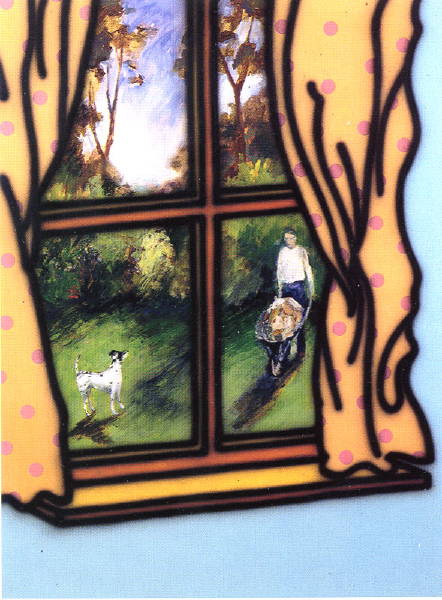Suburban Window 1987 [Howard Arkley & Christine Johnson]

Alternate title: Suburban Landscape
Synthetic polymer paint on canvas, 160 x 121
signed, dated and titled on reverse [‘Suburban Window / 1987 / Howard Arkley’ – according to Christie’s 4/96]
Private collection
This painting first appeared in Arkley’s solo show at Roslyn Oxley9 in September 1987 (where it was listed as “Suburban Landscape”). A Polaroid photo in Arkley’s files (dated on the back June 1987) shows the work incomplete, together with Happenstance (1987), also unfinished.
Four years later, the present canvas was included in the Arkley survey at Monash, now as Suburban Window (the title by then inscribed on the back of the canvas, along with Arkley’s name and the date). In 1996, it was auctioned by Christie’s in Melbourne; the catalogue entry noted the 1987 and 1991 exhibitions, and reproduced the work as shown here.
Prior to Arkley’s death, the painting was exhibited and reproduced as by him alone. However, in an astute review of the Roslyn Oxley9 show, published in the Sydney Morning Herald in Sept.1987, critic John McDonald drew attention to the obvious stylistic disparity involved, concluding that Arkley “has collaborated with another artist who has painted a cosy, backyard scene which we view through a window in one of Arkley’s bright household interiors.” And, as Ashley Crawford and Ray Edgar observed in Spray (1997), the composition is a rare instance of “human presence” in Arkley’s otherwise largely “soulless” suburban oeuvre (it is unclear which version is meant: see below).
These unusual characteristics were finally explained in 2001, in an interview with Christine Johnson, Arkley’s partner at the time it was produced (see Litson 2001). As Johnson revealed, the painting (which she called “Suburban Landscape”) was in fact the result of collaboration between her and Arkley. She contributed the freely painted garden, man and dog; he added the window frame and polka dot curtains, using his characteristic flat comic-book colour and black sprayed line-work. In the 2001 interview, Johnson also noted that the figure with the wheelbarrow was based on her memory of her father, who died when she was nine years old.
For a closely similar variant, see Suburban Landscape 1987 [Howard Arkley & Christine Johnson], also dated 1987 and also originally described as Arkley’s sole work, first documented in the “Greenpeace Artists’ Benefit” exhibition at Linden Gallery, St Kilda, in July 1990. Again, the notion of an “obvious stylistic disparity” – which, Johnson recalls, proved popular when the present work was shown in Sept.1987 – was central. However, Johnson suggests, the painting shown at Roslyn Oxley9 should be regarded as the originary and arguably better work (communication with the author, 5 Oct.2015).
The clear contrast between Arkley’s own apparently inexpressive sprayed technique and the “painterly” detail of the garden scene appears to have sparked similar experimentation with contrasting style and technique in other paintings produced by Arkley during the following few years. In Stucco House (1988), for example, the sprayed line-work is in creative tension with various passages of relatively thick paint and visible brushwork. Similar comments apply to significant areas of other works of the late 80s such as Waterfall 2 1988, Hedge on Street Corner 1988 and its MCA variant Untitled [Hedge] (1988), and Arkley’s factory compositions beginning with Shadow Factories (1988). Similar stylistic contrasts – again generated through a collaborative process – also form part of the “pictorial battle” he waged with Juan Davila in their major installation work Blue Chip Instant Decorator: a Room (1991-2) [3/M] [Howard Arkley & Juan Davila].
[NB the details listed here supersede an earlier catalogue entry, in which the provenance and exhibition histories of this painting and Suburban Landscape 1987 [Howard Arkley & Christine Johnson] were conflated inadvertently. Many thanks to Christine Johnson, Victoria Lynn and Anthony Fitzpatrick, for helping to unravel the complex history of both works in 2015, and also to Asta Cameron of Menzies Art Brands for further assistance in distinguishing the two variants more clearly in Feb.2025.]
Provenance
- Auctioned by Christie’s, Melb., 29 April 1996, lot 47 (as Arkley’s work; details as above; ill.; est.$8-12,000; not sold)
- Private collection (date of acquisition unknown)
Exhibited
- HA Roslyn Oxley9, 9/87, cat.6 (as Suburban Landscape, 160 x 122 cm; priced at $4,000)
- HA Monash 1991, cat.67 (as Suburban Window 1987, 160 x 121 cm, signed, dated & titled on reverse; noted as courtesy Roslyn Oxley9)
Literature
- McDonald 1987 (quoted)
- Duncan 1991 (HA Monash exh.cat.), cat.no.67
- Crawford & Edgar, Spray (1997), p.127 (possibly referring to either this work or its variant)
- Litson 2001 (Christine Johnson interview)